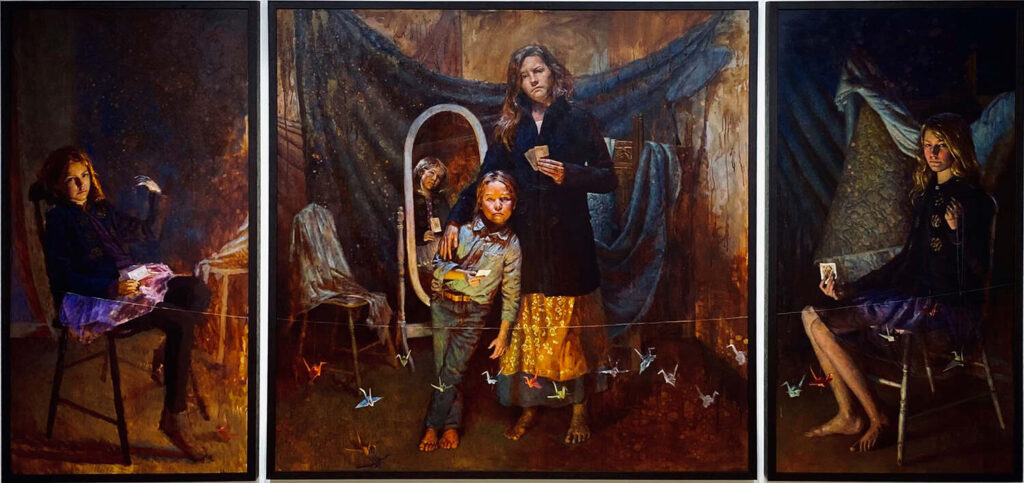Portraiture is a centuries old artform. When we think of portraiture we often think of depictions of great kings and queens, self-portraits of famous artists or works such as the Mona Lisa and the Girl With a Pearl Earring. But for American painter Seth Haverkamp, portraiture means one thing, showcasing his love for his four children. Softness and warmth radiate from each of his paintings as he captures moments of his muses youth showcasing their distinct personalities. Speckles of light, like fairy dust, dance around his paintings embodying his fatherly love and how his children are quite literally the light of his life.
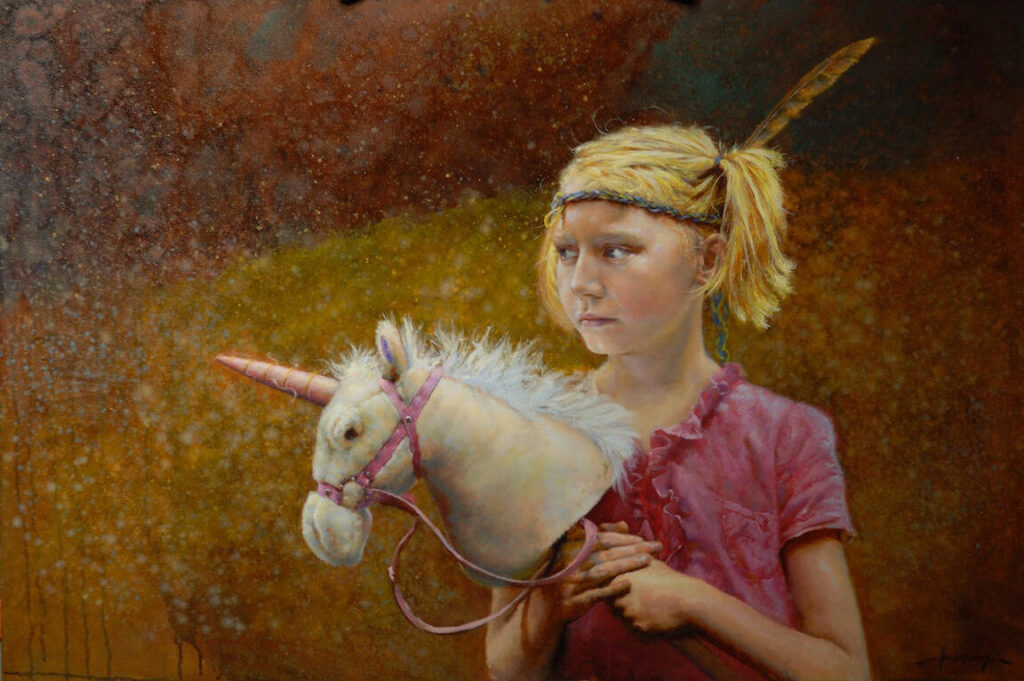
Seth Haverkamp specialises in portraiture and still life. In 2003, he graduated from Carson Newman College with a BFA in Painting and has studied under the guidance of Nelson Shanks Studio Incamminiati and Robert Liberace. His painting style utilises a minimal colour palette of red, blue, yellow, purple, cadmium orange and white and he often prefers to use these colours at their purest rather than mixing them.
His unique approach to colour is amplified by his use of form and the dramatic ambience created using light and darkness within his work. Seth has found international acclaim winning a number of awards including the Portrait Society of America’s Draper Grand Prize (2019) and the People’s Choice Award in America’s International Portrait Competition (2013). His work has featured in a number of art magazine publications as well as in exhibitions across the United States as well as in museums and private collections including the Art Renewal Center Museum and Katherine Weymouth’s private collection.
I find oils to be very forgiving and very beautiful. They glow from within. There are so many different techniques and approaches to fulfill any whim. I also love knowing that I’m painting with the same media as Leonardo and Michelangelo, all these centuries later.
Exclusive Interview with Seth Haverkamp, 2019 recipient of the Portrait Society of
America International Competition Draper Grand Prize, represented by Bender Gallery in Asheville, North Carolina. Bender Gallery Associate, Amanda Kendrick-Deemer, called the artist and painter, Seth Haverkamp, and they had a spirited chat discussing his current paintings, his upcoming 2024 solo show at Bender Gallery, and the common motifs throughout his work.
Hey there. It’s great to meet you, even if over the phone. Tell me a little about yourself,
your art journey, were you into art growing up, if so, what were you making back then?
Art was the thing I was good at. I remember as early as the age of five always drawing. In fifth
grade, I turned in ten drawings of birds of prey with some text as my science fair submission. I was always trying to find ways to make my assignments drawing related. My dad was a sculptor and art therapist, and my grandpa was a talented Sunday painter. So, I guess you could say it runs in the family. When it came to decide on college, the only real option was art school, and my parents were very supportive. I received my BFA from Carson Newman College in Knoxville, TN.
Tell me about an important life moment that greatly influenced the direction of your work.
In 2004, I saw a painting by Nelson Shanks on the cover of an art magazine. It stopped me in my tracks, and I found a way to take a workshop with him in Philadelphia. Within the first twenty minutes of the class, my life was changed. He was teaching how to get a painting started within minutes, no time-consuming drawing required, which was what I had been doing up until that point. I knew then I needed to move to Philly to study under him, and within a year my family and I had moved up there and I trained with Shanks for ten months. I learned how to start a painting, but I didn’t know what I wanted to paint. It led to still lifes and then painting my
children.
What are you working on right now? Do you already know what works will be in your fall
solo exhibition at Bender Gallery?
I’m painting a lot of children and landscape-y, not realistic, impressions of the world. I’m playing with light, warms and cools, and most of my paintings in the show will have multiple light sources. One of the paintings is of my niece with a dragon fly that’s glowing, and she’s immersed in a sketchy, abstract background.
I’m interested in hearing about how you envision the setting or atmosphere your figures
are in.
I choose objects to fill the space with interest. An object doesn’t necessarily have a particular
meaning, rather it could be about the folds of the blanket and the way the light hits certain areas. I want the different shapes to morph into a realistic three-dimensional object. Chair arms or a portion of a wall can shift the abstract background into something more real. It doesn’t matter that I’m colour blind, I can focus on the warm and cool light and sculpt forms using the purity of colour to turn forms and make shapes.
I push the sense of drama which is supported by the (somewhat) abstract backgrounds I create. I use a limited palette, usually just five colours, but that is transformed through mixing in order to paint the rainbow on a person.
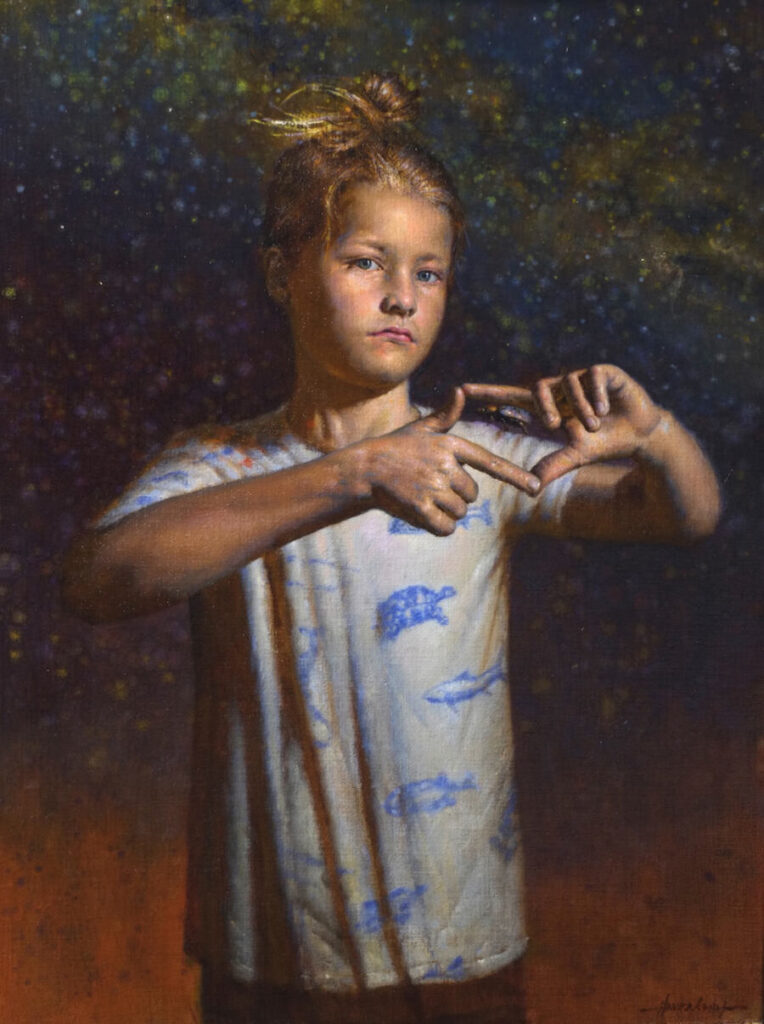
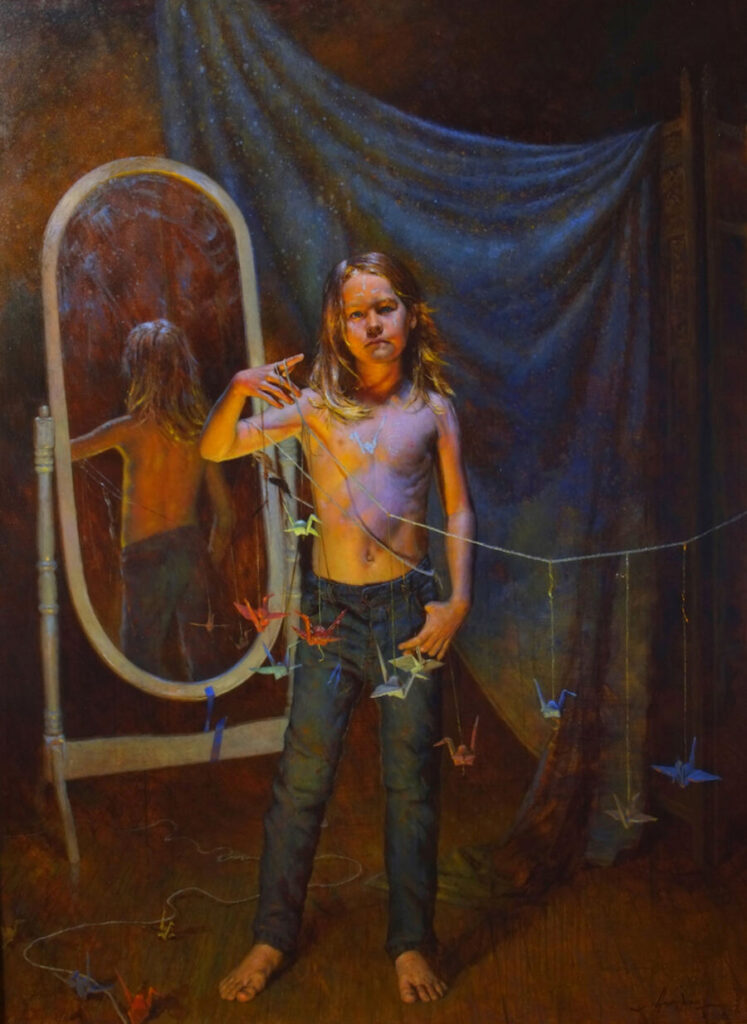
You use branches and origami often in your work. Can you tell me about why you use these
particular items?
I learned how to do origami as a young kid and still love it. The different values assigned to
planes on the folds of origami hold my interest. The crown of branches bring nature into the
scene. Sometimes I will bring branches to a photoshoot with my kid, and they will come up with ideas that will influence the outcome of the painting. It’s basically like a family collaboration.

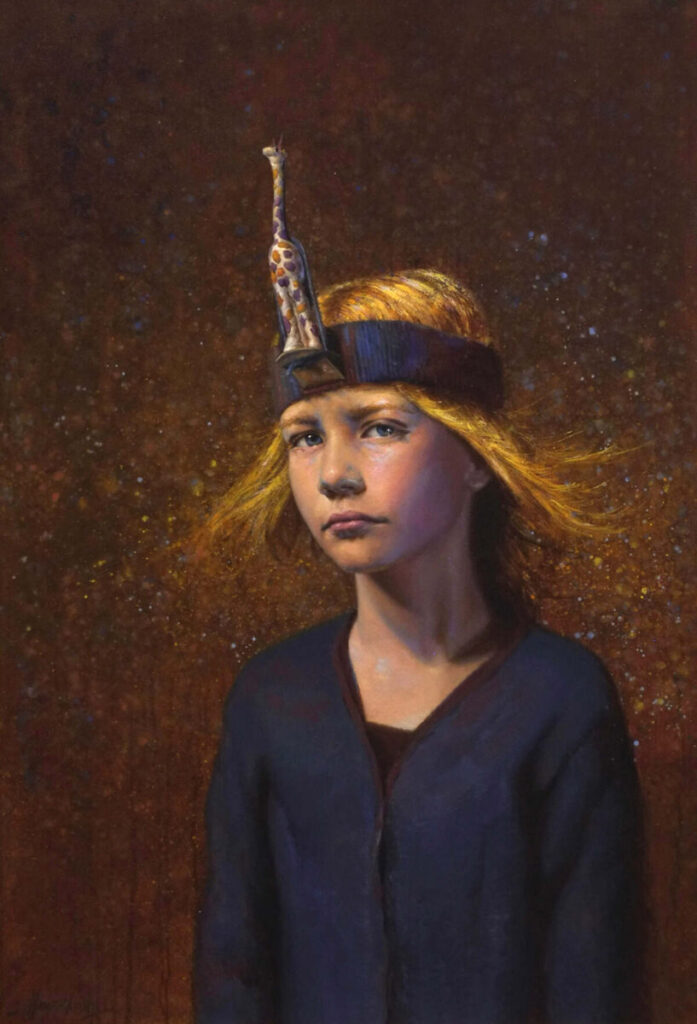
How many children do you have? Will you always paint them?
I have four kids. I will always paint them. There will just need to be a different scenario when
they are adults. There are certain poses or props that can work with a nine-year-old that just
won’t work with a 19-year-old. I could see in the future doing more serious portraits of them
when they are older. Maybe they’ll be doing something and not looking out at the viewer. In
most of my past portraits, the model is looking out at us. This method facilitates engagement
with the viewer.
Why are all your figures barefoot (except for ‘Red Boots’ of course)?
Shoes date things. They aren’t necessary. Feet are hard to get right, and that interests me. There’s something organic and natural about a shoeless kid. Hands are one of the most important elements in a portrait. I’m always questioning ‘how do I get hands into this scene in a natural way?’. That’s another way that the props come into play. How can they wear this crown and have their hands positioned in a certain way that it becomes another focal point.

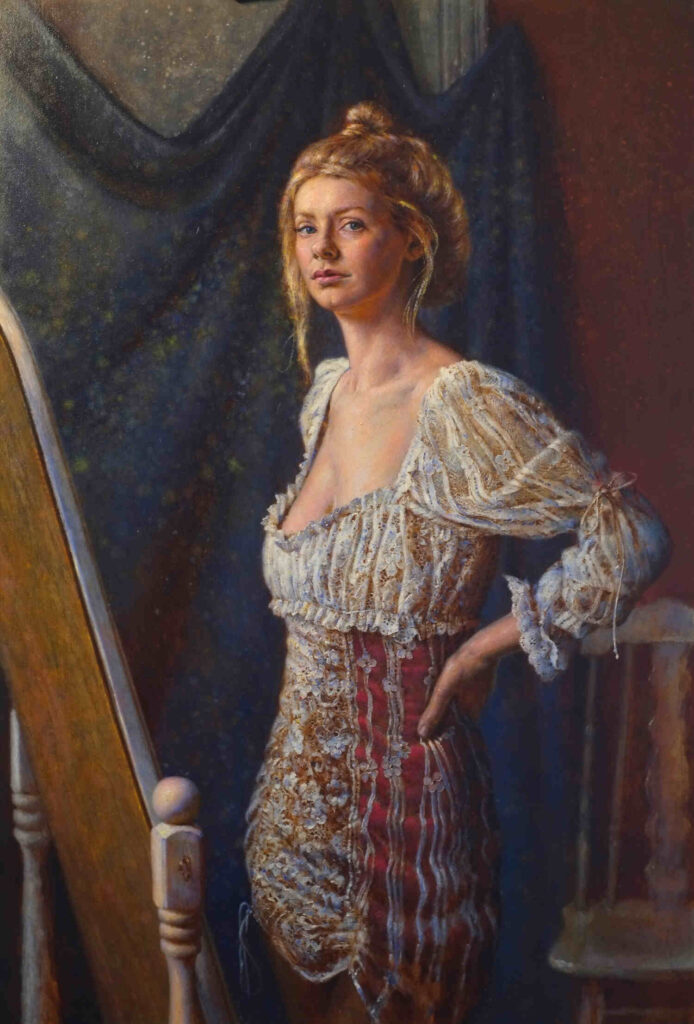
As an oil painter myself, I’m extra curious to hear, what do you love most about the
medium you have chosen to work in?
I find oils to be very forgiving and very beautiful. They glow from within. There are so many
different techniques and approaches to fulfill any whim. I also love knowing that I’m painting
with the same media as Leonardo and Michelangelo, all these centuries later.
If you had to choose three words that you feel best describes your work, what would they
be, and why?
I have a hard time with choosing three. I would want people to see and describe my work as magical. Portrait painting can be mundane, and my goal is to bring it out of that and be anything but ordinary. I love working with blue and orange light because it makes the portrait feel like something more than reality.
Shoes date things. They aren’t necessary. Feet are hard to get right, and that interests me. There’s something organic and natural about a shoeless kid.
Tell me about your typical studio routine. What do you listen to in the studio?
I paint on a painting in the morning, and then paint on a different painting in the afternoon. I
prefer to work on two to three paintings at a time especially because they’re in different stages of drying. If I’m working on the background, I splash oil paint thinned with solvent to create my abstract backgrounds. I usually listen to classic rock or NPR podcasts. Sometimes I’ll put on a Netflix show and listen to that. It’s always nice to mix it up.
Who is the model with the red hair in ‘Wynter at Night’? Is her name Wynter and is her hair that colour?
Yes, her name is Wynter. Her hair wasn’t actually red when I painted her portrait. It was a pale blue colour. That’s a good example of colour not needing to be the same that is witnessed in real life. My paintings aren’t necessarily “real” because I create my own environments and switch up the colours.
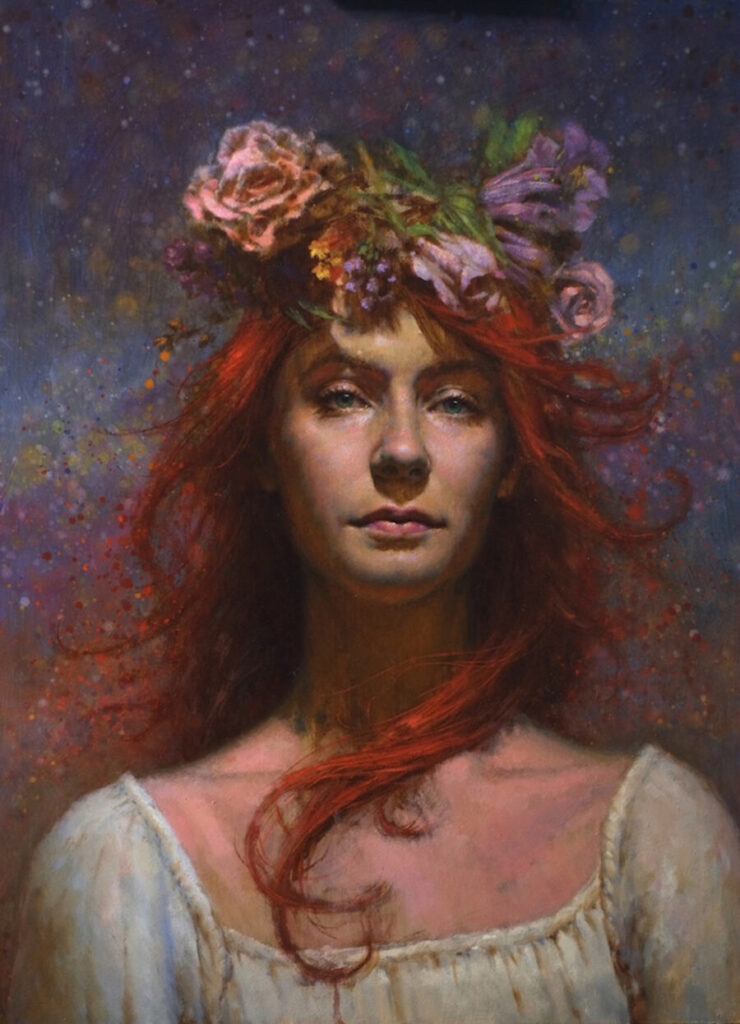
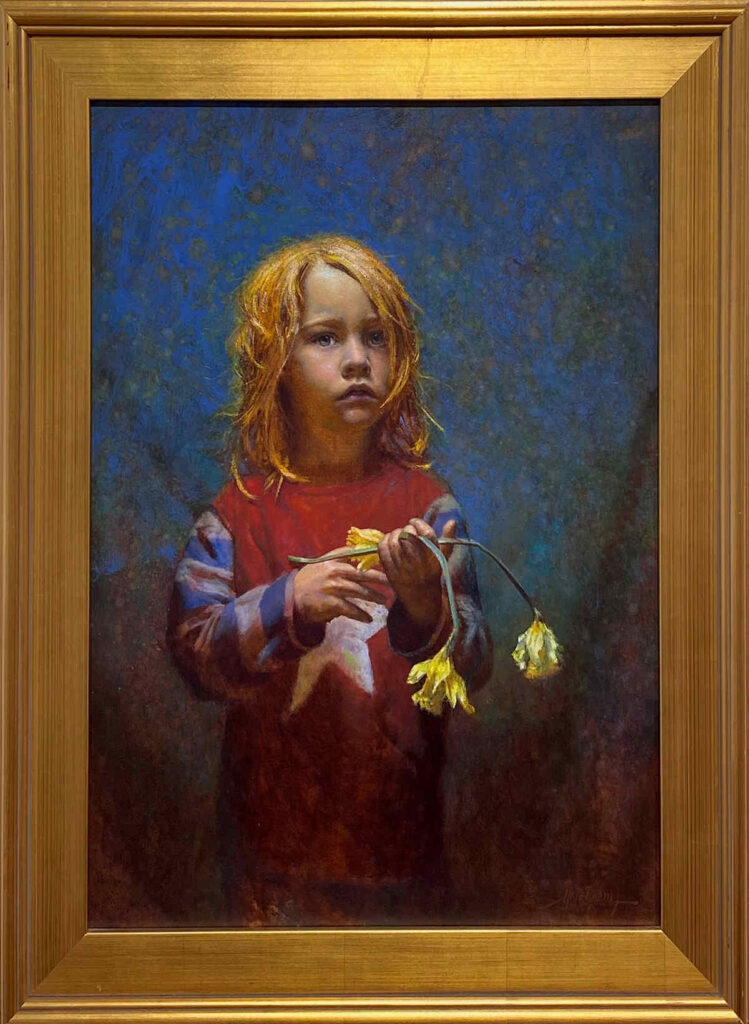
What advice did you get as a young artist that still influences you today?
Because of my obstinate nature, I would say the repetitive phrase of ‘How are you ever going to turn this into a career?’ was the driving force. Some advice I like to give to my own students is ‘Mess up as much as possible, it’s not the accomplishments that allow you to learn but the failures’.
Seth Haverkamp will have a solo show at Bender Gallery in the fall of 2024. Keep an eye on
their social media for updates. Check out Seth’s available work here: Bender Gallery!


